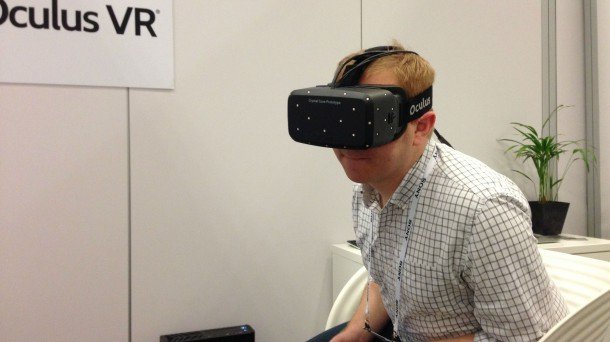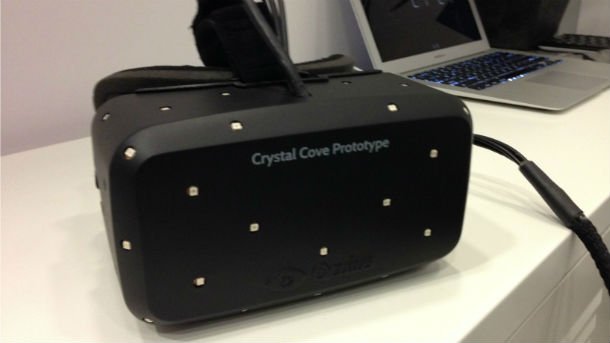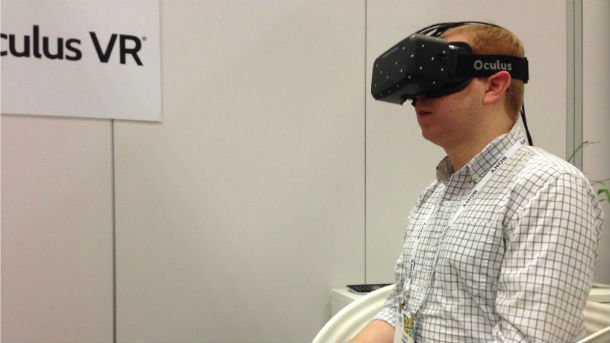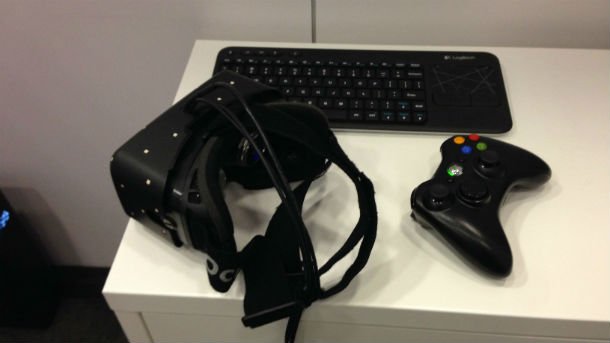Oculus Rift "Crystal Cove" prototype hands-on at CES 2014

That's me, leaning forward in the cockpit during my Oculus Rift demo of EVE: Valkyrie this morning. I'm reading the words printed on a screen to the left side of my cockpit, as my fighter sits in the launch bay. The words were blurred as I reclined in the char, but came into sharp focus as I got closer.
But there's something else, something more subtle happening in that photo: I'm amazed that I haven't thrown up.
I'd had an unfortunate experience with the Rift in the past. My first hours with the development kit was in the comfort of my own home. I plugged in all of the wires and set up the headset as a second monitor, per the included instructions, and launched headlong into Half-Life 2. But instead of wonder and amazement, I was filled with an immediate sense of dread and discomfort. I made my way through City 17's checkpoints slowly, as if every forward push on the keyboard was difficult. Once—and only once—I looked behind me, which made my body feel as if it were filled with poison that desperately needed to come out.
After 20 minutes—right about the time the Combine soldiers started chasing me—I threw up.
Oculus VR founder Palmer Luckey's eyes widen when I tell him the story at our meeting. Only one other person has reported vomiting, he tells me, and then mentions that the instructions with the development kit explicitly state to stop using the headset when discomfort occurs. I smile at this. Who follows instructions?

So it was with a little bit of fear that I strapped on the company's newest prototype, code named "Crystal Cove." The unit itself is slightly smaller, but noticably less head-fatiguing, and runs at 1080p resolution. The biggest improvement, however, is the unit's enhanced positional tracking and motion blur technologies. The white dots on the front of the headset? Those are tracked by a camera set up on the television in front of me, and are watching my movements. I lean forward in the Unreal Engine 4 demo—a cavernous dungeon where orcs are running, tower defense style, and can be killed with traps, all while a giant horned demon watches—and can look down into the depths. I lean even closer still and can see the fat, hobbling orcs enter the maze, then get charred to a crisp as I press a button on the controller. The movement is much smoother, even without an intensive amount of calibration, Looking side to side gives me a full view of the dungeon, but doesn't give my stomach the willies.
Of course, this is all while I'm sitting still, with no forward motion to worry about. My second demo is with EVE: Valkyrie, and its fast-paced space combat has me nervous. After reading the displays and looking down at my fake digital body, all signs are go for launch. For just a moment, I want to stop. This could be where my Starbucks muffin comes back to haunt me.
The biggest gaming news, reviews and hardware deals
Keep up to date with the most important stories and the best deals, as picked by the PC Gamer team.
3, 2, 1. Launch.
Immediately, I look up and to the right, gazing at the asteroids around me. The positional tracking glides with me, and I feel... fine. Great, even. I'm so amazed that I'm here, in the vastness of space, that I ignore the Oculus employee telling me to lock on to my targets and fire missiles. I hear a crash from the television speakers and the screen goes black. That's my first death.

Take two goes better, as I use my head tracking to lock on to targets with a cursor and fire at will. The right thumbstick on the controller lets me roll to the left, and I take evasive maneuvers as the enemy fires back. I remember how Battlestar Galactica pilots looked as they hurtled their Vipers into dogfights with Cylon ships. Then I remember that I've got a giant mask strapped to my face.
But my breakfast stays where it belongs. I don't even feel any discomfort when looking behind me or shifting around in my seat. It feels fantastic, and I can't wait to try other, larger games with it.
Luckey says the company doesn't know when its commercial version will be released, but the progress on the newest prototype makes me confident that the release can't be too far behind. The motion tracking here addresses every concern I had from my previous experience. Of course, I didn't have to work through the setup of the prototype, or any larger, longer-lasting calibration. And while many tech demos are currently available, major publisher and developer support is a closely guarded secret. But I hope they're working it out, and Luckey sounds confident. "We're really far," he tells me. "We've got really well developed software, we've got really well developed hardware, we're building our team out and we're going to be able to deliver the kind of consumer product that we want to deliver."
After my disastrous first impressions, I was convinced that virtual reality headsets just simply wouldn't work for me, and I'd made my peace with that. Now I'm on the other side, where I can see a VR headset being a regular part of my gaming rig. It's the kind of 180 degree turn I didn't expect to have from the demo—at least without hurling all over the floor.


